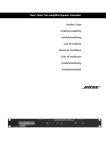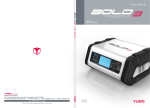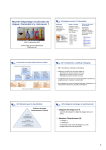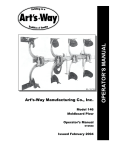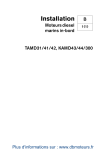Download OPERATING INSTRUCTIONS
Transcript
OPERATING INSTRUCTIONS GÄVLE OIL TERMINALS SHIP - SHORE 2013-12-06 Rev 1.6 2 Table of Contents 1. 1.1 1.2 1.3 1.4 General General regulations Area of application Compliance with instructions Risk management 2. 2.1 2.2 2.3 2.4 2.5 2.6 2.7 Reporting for vessels Advance notice report Information in the report Advance notice report of hazardous goods Additional information in hazardous goods report Permits for certain traffic Copies of advance notice report Ship/Shore Safety Checklist 3. 3.1 3.2 3.3 3.4 3.5 Navigation Restrictions in the shipping lane Passage past moored vessels Anchoring ban Docking at an oil quay Order of docking 4. 4.1 4.2 Technical description of quays Quay 27 Quay 1 5. 5.1 5.2 5.3 5.4 5.5 5.6 5.7 5.8 Mooring Extended stays Mooring equipment Brand wires Mooring alongside Mooring routines Permitted traffic Weather restrictions Electrical storms 6. 6.1 6.2 Technical description of pipelines From Quay 27 From Quay 1 7. 7.1 7.2 Emergency measures Responsibility Alarms 8. 8.1 8.2 8.3 8.4 8.5 8.6 8.7 8.8 8.9 8.10 8.11 8.12 8.13 General regulations for tanker to quay Warning signals Spark arrestors Fire precautions Watchmen Smoking Open flames – hot work onboard Repairs Application Sparks Tank covers and sounding hatches Inert gas facility Loading, unloading, bunkering and ballasting Measures concerning pollution of land and water areas 2013-12-06 Rev. 1.6 3 8.14 Safety equipment landside 8.15 Photography 8.16 Inspection 9. 9.1 9.2 9.3 9.4 9.5 9.6 9.7 9.8 9.9 General regulations in the Oil Terminal Smoking and open flames Hot work permits, safe distances Vehicle traffic Electrical equipment Repairs, safe distances Fire precautions Spills and leaks Access to the Oil Terminal Life jacket 10. 10.1 10.2 10.3 10.4 10.5 10.6 Loading/unloading of petroleum products and liquid chemicals Cargo handling Loading pipes and loading arms Fuel oil pipeline Quay 1 Landside personnel Emergency measures in cases of fire, oil spill and accident Transfer between depots 11. 11.1 11.2 11.3 11.4 Bunkering Regulations Bunkering Officer Method of delivery Advance notice report, restrictions 12. Ballasting 12.1 Regulations 12.2 Ballast water 13. 13.1 Tank cleaning General 14. Summary 14.1 Class 1 product (Petrol) 14.2 Class 2 products (Jet A1, Paraffin/Kerosene) 14.3 Class 3 and other products (EO1-5, Diesel, Biofuels) Annex 1. Annex 2. Annex 3. Annex 4. Annex 5.1 Annex 5.2 Annex 5.3 . Map of Oil Terminal Alarm list Emergency measures Mooring posts Quay 1 Mooring arrangements LOA between 80-130 m Mooring arrangements LOA between 130-180 m Mooring arrangements LOA between 180-240 m 1. General 2013-12-06 Rev. 1.6 4 1.1 General regulations These Operating Instructions have been adopted by the Board of Gävle Hamn AB and apply in parallel with what is stipulated in general statutes and ordinances and in Harbour Ordinances and Harbour Bye-laws. The above publications maybe ordered from Gävle Hamn AB, Fredriksskans, 805 95 Gävle or downloaded from www.gavle-port.se. Operations are otherwise regulated by instructions and recommendations issued by the Swedish Petroleum Institute (SPI), the Swedish Oil Terminal Forum (SOHF) and the latest issue of the International Safety Guide for Oil Tankers and Terminals (ISGOTT). Marine protection is regulated by the ISPS code. 1.2 Area of application Instructions apply to all operations in Gävle Oil Terminals which include Fredriksskans Quay 1 and Quay 27 plus pipeline systems to the various oil depots. (See map in Annex 1) 1.3 Compliance with instructions Everyone who works within the area of application is obliged to comply with the instructions listed above. 1.4 Risk management Oil products and chemicals may produce gases that are flammable and hazardous to health. Consequently special attention is required in order to prevent injury to people and damage to property and the environment. Open flames and smoking are prohibited within the area of application of these instructions. It is also prohibited to carry out hot work within this area of application. Temporary exceptions to this ban may be granted by Gästrike Emergency Services only. Mobile telephones, walkie-talkies, torches/flashlights or other electric/electronic equipment must be EX classed, otherwise they must be turned off. Everyone who enters the area must wear a hard hat and warning jacket plus suitable protective clothes/shoes. Eye protection and/or face masks must be worn when so instructed by supervisors. Vehicle traffic is regulated by general traffic regulations plus that there is a general speed limit of 30 km/hour within the harbour area. Blinking/rotating warning lights must be used within the working area. Any ingestion of listed substances (drugs) or alcohol within the area will result in immediate expulsion from the area plus a report to the relevant authorities. 2. Reporting for vessels 2.1 Advance notice report In addition to what is stated in the Harbour Ordinances, the following applies for the importation of crude oil, all other petroleum products, ethanol and liquid bio-products plus for chemicals in bulk, irrespective of whether they are classified as hazardous goods: An advance notice report of importation at least 24 hours before the vessel’s estimated time of arrival in the harbour and again before unloading is intended to begin. For loading of products listed above, the same time frame applies. In certain cases, however, Hamnbolaget may grant a shorter advance notice period. Advance notice report to be submitted via fax to +46-26-17 88 64 or in writing to Gävle Hamn Trafikavdelningen, [email protected]. 2.2 Information in the report 2013-12-06 Rev. 1.6 5 • • • • • • • • • • • • • • • • • • • • • • • • The name of the vessel, IMO number, call signal, nationality, net/gross tonnage, length/width plus draught. Name of shipping line/operator/manager, charterer, broker and recipient. Estimated time of arrival (ETA) at pilot station. Title of goods, number of tons to be unloaded, transited or loaded. Quantity to be loaded in TOV plus product’s mean temperature. Class certificate/IOPP certificate, date of expiry. ISPS safety level. Vetting approval, company and date. Current air draft to manifolders, number and dimensions. Dimension and length of cargo pipes onboard. Type of cargo pumps, typical unloading capacity, max. unloading pressure. Calculated unloading period. Number of tanks to be loaded/unloaded. Inert tanks, open/closed sampling. Mooring equipment wire/tail or fibre, dimension, autowinches. Number of tons of oily bilge water or sludge to be off loaded. Quantity of bunkers to be delivered. Quantity of fresh water to be delivered. Application for prewash at quay, number of tons of wash water to be off loaded. Quantity of garbage to be off loaded and classifications of its fractions. Reception of provisions/spare parts. Cargo harbour of origin, immediately preceding harbour and next harbour. Crew list. Crew changes. 2.3 Advance notice report of hazardous goods Includes dangerous chemicals in bulk according to IBC and BCH codes plus flammable liquids with a flash point of +60°C or lower. Also gases to which the IMO transport code is applicable. Regulations in SJÖFS 2006:34-35 and ICS Tanker Guide Chemicals must be complied with, plus that the advance notice report must include the information stipulated above in 2.2 with additions stated below in 2.4. 2.4 • • • • • Additional information in hazardous goods report The chemical/technical name of the goods and information on any dangerous, component parts. UN number. Class according to IMDG Code. Flashpoint (closed cup). Security data sheet and information on any other special security measures and risks. 2.5 Permits for certain traffic Hazardous goods may not be imported into the Oil Terminal without permission from Hamnbolaget. These permits are based on the information stated in Point 2 above. The permit states the special measures that are required considering the nature of the goods. 2.6 Copies of advance notice report Copies of the completed advance notice report must be submitted to the recipient depot and Unloading Supervisor before the arrival of the vessel. 2.7 Ship/Shore Safety Checklist The Port of Gävle’s Ship/Shore Safety Checklist must be applied and is available on its website 3. Navigation 2013-12-06 Rev. 1.6 6 3.1 Restrictions in the shipping lane Please Note! Always check with current Hamnbolaget Harbour Regulations for any amendments. For passage through the northern shipping lane (Holmuddsrännan) daylight: Max length 220 m, Max width 28 m, Max draught 10.10 m. Max length 200 m, Max width 30 m, Max draught 9.00 m. For passage through the northern shipping lane (Holmuddsrännan) in darkness: Max length 180 m, Max width 25 m, Max draught 8.6 m. If necessary, the Harbour authorities may enforce temporary changes to the criteria stated above. All depth conditions refer to average water surface which is located 2.60 m above Gävle’s chart datum. Height system GS55, (MVY2008). Density 1.003. 3.2 Passage past moored vessels Vessels may not be moved closer than 25 m to moored tankers. 3.3 Anchoring ban Anchoring ban applies according to current sea chart. Vessels may not anchor or drag anchor within the marked areas. If this occurs, the incident must be reported to the Harbour Administration. 3.4 Docking at an oil quay Vessels that are to load or unload Class 1 products may not dock at the oil quay until permission has been granted. The All Clear signal is projected 24/7 from the signalling mast at Quay 27 by vertical, unblinking green lights. • 1 green light – Vessel may dock at Quay 1 • 2 green lights – Vessel may dock at Quay 27 3.5 Order of docking Hamnbolaget confirms bookings and allocates quays and order of docking, taking into consideration the prevailing or expected traffic situation. Hamnbolaget bears no responsibility for delays or other consequences caused by changes to the traffic situation or by other events beyond the control of Hamnbolaget. 4. Technical description of quays 4.1 Quay 27: • Is intended for loading and unloading of petrol (US - gas), diesel, paraffin (US - kerosene), Jet A1 and similar products. • Four, hydraulically manoeuvred loading arms with 10” and 12’’ connection manage the import/export of products. • Loading arms are equipped with insulating flanges. • No gas return. • Arms’ area of operation - height: 10’’ Max 16.4 m, Min 2.4 m from average water level. 12’’ Max 19.1 m, Min 2.4 m from average water level. • Arms’ area of operation towards vessel: 10’’ Max 7.5 m, Min 1.5 from outer edge of fenders. 12’’ Max 7.5 m, Min 1.5 from outer edge of fenders. • Quay construction of concrete, 80 m long and 2.9 m above average water level. • Equipped with 4 fenders. • Greatest permitted draught for vessels at average water – 10.10 m. • Water depth at 2002 rounded up/down average water level – 10.70 m. • Max permitted length of vessel at Quay 27: 220 m. 2013-12-06 Rev. 1.6 7 4.2 Quay 1: • Is intended for loading and unloading of heavy oils, slurry and liquid chemicals. • The heavy oil pipeline is served by a loading pipe with an 8” connection, length 15.0 + 7.0 m. Quay manifolder is equipped with an insulation flange. • No gas return. • One small hydraulic crane is mounted on the quay. Area of operation – SWL: 1.8 m – 3.87 t to 12.2 m – 0.32 t. • Quay construction consists of three monoliths connected by walkways. Total length 87 m and 1.85 m above average water level. • Three fenders on the middle monolith and two fenders on each other outer monoliths. Each fender consists of 12 tyres suspended horizontally on a steel beam and attached to the quay with chains. • Each monolith is equipped with one mooring post. There is a mooring buoy located to the east of this facility, one mooring post close to where the walkway reaches land plus two other mooring posts Southwest and West of the facility that are also on shore. Please refer to Annex.4. • Greatest permitted draught for vessels at average water – 8.80 m. • Water depth at 2002 rounded up/down average water level – 9.50 m. • Max permitted length of vessel at Quay 1: 185 m. • Max permitted width of Vessel at Quay 1: 28 m. 5. Mooring 5.1 Extended stays Vessels that are neither loading nor unloading may not remain in the Oil Terminal without special permission from Hamnbolaget. 5.2 Mooring equipment When mooring tankers, ropes or wire with a noose of rope must be used. 5.3 Brand wires After mooring, two wires of the necessary strength will be thrown from the outer side of the vessel, one fore and one aft, down to the water level. They must be well secured to mooring posts on board the vessel and arranged to allow a towing length of 40 m. 5.4 Mooring alongside Mooring of vessels of any kind alongside another vessel may only be carried out after permission has been granted by Hamnbolaget. 5.5 Mooring routines Recommendations, issued by the Oil Companies International Marine Forum (OCIMF), and published in the Mooring Equipment Guidelines must, to the extent practically possible, be followed. 5.6 Permitted traffic Vessels of any type may not enter or moor at the Oil Terminal without the permission of Hamnbolaget. 5.7 Weather restrictions Maximum permitted wind force at loading/unloading: 22 m/s. At 25 m/s, the loading arm must be drained and made ready to disconnect. Maximum wind force for permission to remain at quay: 30 m/s. The above are to be regarded as recommendations and in no way relieve the Captain of the vessel and the Unloading Supervisor from their liability. Hamnbolaget may take decisions concerning deviations from these restrictions if it is considered necessary as concerns prevailing/anticipated weather conditions. 5.8 Electrical storms If thunder and lightning are imminent, all cargo handling of Class 1 products or other processes in which flammable gases are formed, must cease on the quays. All tank openings and valves onboard must be closed, including the by-pass valves in the ventilation systems of cargo tanks. All valves connected to the loading arm and land manifolder must be closed. 2013-12-06 Rev. 1.6 8 6. Technical description of pipelines 6.1 From Quay 27 Four separate pipelines exit from the quay manifolder with connections to the various depots and rock 3 caverns. In normal cases a maximum pump speed of up to 1200 m /h and maximum pressure of 8 Bars in the quay manifolder. The pipeline is washed out after each unloading using pumps from two of the bilge stations. 6.2 From Quay 1 Different pipelines of different diameters are used for unloading depending on the product to be unloaded. Typical length for pumping black fuel oil is approximately 1 km and the diameter of the pipeline is between 300 mm and 350 mm. The maximum values stated above generally also apply to fuel oil. The pipelines are blown through using compressors after unloading has been completed. 7. Emergency measures 7.1 Responsibility The Unloading Supervisor landside and the Captain onboard will, within their respective areas of responsibility, ensure that information on measures to be taken in the event of accidents or incidents involving hazardous goods is continuously accessible. Such information must also include Emergency Procedures for Ships Carrying Dangerous Goods (EmS) and Medical First Aid Guide (MFAG) and/or other similar information. 7.2 Alarms All personnel concerned, landside and on board must, before cargo processing begins, establish where the closest alarm is located and how it is used. This includes how to send an alarm to Gestrike Emergency Services. The emergency stop function, onboard and landside, must be understood by all personnel on board and on land. Please refer to information in Annex 2. 8. General regulations for tankers to quay 8.1 Warning signals Tankers must, in daylight, fly signal flag B and in darkness show a red signal light installed in their signal mast. 8.2 Spark arrestors All types of vessels entering the Oil Terminal must be equipped with efficient spark arrestors on funnel and exhaust pipes. 8.3 Fire precautions The vessels’ fire fighting systems and decontamination equipment for oil spills must be in good order. 8.4 Watchmen Vessels in the Oil Terminal must always post a competent watchman on deck. If the watchman is not part of the crew of the vessel, he/she must be approved by Hamnbolaget. The watchman must: • Be very familiar with Chapters 7 and 8 of these Operating Instructions and possess good knowledge of existing safety equipment located on the quay. • Be available on deck so that the gangway and mooring equipment can be adjusted. • Check that no oil spillage occurs from the vessel. • Check visitors according to the ISPS Code. • Monitor that the smoking ban is maintained. • Assist the Captain to monitor that both vessel and harbour safety instructions are followed and pay attention to activities in the proximity of the vessel. 2013-12-06 Rev. 1.6 9 • • • Cooperate with landside personnel so that risks to safe unloading are avoided. Report to Captain and/or Unloading Supervisor on events that might be dangerous. Eject any individuals under the influence of alcohol or other listed substances. If such an individual is employed on the vessel, he/she must be taken onboard under the command of the Captain or Acting Captain. 8.5 Smoking There is no smoking on all open decks of all vessels. Space allocated for smoking by the Captain of the vessel may be used only. No smoking notices must be clearly visible. 8.6 Open flames – hot work onboard Open flames or hot work, e.g. welding, may not be undertaken onboard. The exception is open flames in the smoking areas. 8.7 Repairs Repairs onboard (including testing of radio transmitters and other electronic transmission equipment) may not be undertaken without permission from Hamnbolaget. Exceptions are minor repairs that require the use of hand tools only on the condition that: • No open flames are used. • That the vessel’s ability to move under its own steam is not affected. 8.8 Application Points 8.2 to 8.9 also apply to vessels that are not carrying hazardous goods but that are located less than 25 metres from a vessel with hazardous goods onboard. 8.9 Sparks If sparks are observed coming from the vessel’s funnel, immediate measures must be taken to stop such processes. 8.10 Tank covers and sounding hatches All openings onboard must be closed unless supervised sampling or ullage measurement is underway. 8.11 Inert gas facility Concerning the utilisation of the inert gas facility in the Oil Terminal, recommendations in the latest issue of ISGOTT are to be followed. • Inert gas or gas mixture is defined as gas that is unable to maintain combustion and that contains les than 5% oxygen. • Inert gas safe space is defined as space in which the oxygen level after inertion does not exceed 8 volume percent. 8.12 Loading, unloading, bunkering and ballasting Regulations concerning loading/unloading/bunkering/ballasting are stated in Chapter 10. For loading or unloading of general cargo/provisions/spare parts in the Oil Terminal, permission must be granted by Hamnbolaget. 8.13 Measures concerning pollution of land and water areas Within Swedish land and marine territories it is forbidden to emit dangerous substances or to pollute with waste, garbage, etc. In the Oil Terminal there are facilities to accept a limited quantity of ballast water/sludge and other dangerous substances and waste. 8.14 Safety equipment landside Captains and other officers onboard are obliged to make themselves familiar with safety equipment landside, including knowledge of: • Location of fire extinguishing equipment, ship-shore connection and decontamination equipment for oil spills. • Location of telephones and alarm points for contact with the Emergency Services. 2013-12-06 Rev. 1.6 10 8.15 Photography Permission to take photos may be granted by Hamnbolaget on the condition that: • Current safety regulations are observed as concerns risk of fire. • Current confidentiality regulations are observed. 8.16 Inspection Hamnbolaget and the Emergency Services are entitled to inspect vessels as concerns compliance with current regulations. The Captain is obliged to comply with the inspectors’ instructions and facilitate their work by providing the necessary assistance. 9. General regulations for the Oil Terminal 9.1 Smoking and open flames The no smoking rule is enforced within the area of application of these instructions – indoors, outdoors and in vehicles. The manager of the facility may allow smoking in space approved by the local building committee for this purpose. 9.2 Hot work permits, safe distances Hot work may be carried out during loading and unloading of tankers only if the following criteria are fulfilled: • A valid hot work permit has been issued by the Emergency Services. • That personnel carrying out the job possess valid hot work certificates. • That the distance between the hot work and the pipeline is at least: 25 m when loading/unloading Class 1 products. 15 m when loading/unloading Class 2 products. 10 m when loading/unloading Class 3 and other products. 9.3 Vehicle traffic All vehicle traffic and use of combustion engines on the oil quays is forbidden when loading/unloading Class 1 and 2 products. Tractors and other working vehicles may not be used under the pipeline when Class 1 products are being loaded or unloaded. Passage of vehicles is only permitted on the local road network. 9.4 Electrical equipment For electrical equipment the latest safety regulations issued by the Swedish National Electrical Safety Board will apply. Connection of electrical equipment may only be carried out via approved connection points. 9.5 Repairs, safe distances Minor repairs, carried out with tools that do not produce sparks, are permitted during the unloading/loading of the vessel. Exceptions to the safe distances stipulated in Chapter 9.2 may, in certain cases, be allowed by Hamnbolaget in consultation with the Unloading Supervisor. 9.6 Fire precautions The manager of the facility will ensure that the facility’s fire extinguishing equipment is in good working order and that ship-shore connections are ready for use. 9.7 Spills and leaks • In locations where spills and leaks may occur (valves, tap crane, etc.) and where there is no permanent arrangement for the collection of escaped liquids, a spill tub must be used. • When handling Class 1 and Class 2 products, all collecting vessels must be earthed. • Valves, tap cranes, air gauge or similar equipment for emptying, sampling, drainage of water or similar must be kept locked, sealed or end capped if there is any risk of unauthorised use. 9.8 Access to Oil Terminal Only authorised individuals with valid pass cards may enter the area. Visitors/relief crews must be reported to the gatekeeper. 2013-12-06 Rev. 1.6 11 9.9 Life jacket Life jacket must be worn at berth 1 and berth 27 10. Loading/unloading of petroleum products and liquid chemicals 10.1 Cargo handling Loading and unloading of tankers must always be carried out according to recommendations issued by ISGOTT and current regulations applying to the Oil Terminal. Please refer to Chapter 1. 10.2 Loading pipes and loading arms Only approved loading pipes and loading arms, tested during the previous twelve month period, may be used. 10.3 Fuel oil pipeline Quay 1 In temperatures of less than +5°C, ”pipeline ready” must be verified by ”trial blow through” before loading/unloading may be initiated. When pumping the product’s temperature may not exceed 70°C and the temperature must always be maintained at a minimum of 20°C above pour point. 10.4 Landside personnel The relevant Unloading Supervisor plus safety/management watchman/men must always be present during loading/unloading of tankers plus when washing through pipelines. The safety watchman must always be present on the quay when vessels carrying Class 1 products are moored, irrespective of whether the vessel is cargo handling or not. 10.5 Emergency measures in cases of fire, oil spill and accident Please refer to Annex 3. 10.6 Transfer between depots Transfer between depots in the Oil Terminal shall be notified to the Port of Gävle. Notification must be made in good time, but at least 24 hours before the operation begins. The form of the Port of Gävle website is to be used and sent to the Port of Gävle for confirmation. The transfer can only start when the responsible depot has received confirmation from the Port of Gävle. Receiving depot is responsible depot. Unloading and loading always takes precedence over pumping between depots 11. Bunkering 11.1 Regulations The reception of bunkers must always be carried out according to MARPOL regulations and ISGOTT recommendations. The ISGOTT checklist must always be followed and properly filled in. 11.2 Bunkering Officer The Captain of the recipient vessel must, before bunkering, inform Hamnbolaget of the name of the relevant Engineering Officer in charge of bunkering. 11.3 Method of delivery Bunkers are normally delivered by tanker truck only. Vehicles may park on the oil quay, close to the side of the vessel. 11.4 Advance notice report, restrictions In addition to Hamnbolaget, the Unloading Supervisor/safety watchman plus the emergency services must be informed when bunkering is intended to begin. Bunkering may not be carried out at the same time as the loading/unloading of Class 1 and Class 2 products. 2013-12-06 Rev. 1.6 12 12. Ballasting 12.1 Regulations Ballasting must always be carried out according to MARPOL regulations and ISGOTT recommendations. 12.2 Ballast water Only clean ballast water may be released into Oil Terminal waters. Clean ballast water is defined as water that has been transported in separate ballast water tanks, that have no connection with any cargo tank or water that has passed through a separator so that the released water’s oil content does not exceed 15 ppm. 13. Tank cleaning 13.1 General Tank cleaning is normally not permitted at the oil quays. Hamnbolaget may, however, permit such activities in exceptional circumstances. 14. Summary 14.1 Class 1 product (Petrol) Safety watchman must always be on duty, even if there is no cargo handling underway. Sludge disposal may only be carried out before or after loading/unloading. Bunkering may only be carried out before or after loading/unloading. Vehicle traffic on the quay is forbidden during loading/unloading. 14.2 Class 2 products (Jet A1, Paraffin/Kerosene) Safety watchman must be on duty during loading/unloading. Sludge disposal may only be carried out before or after loading/unloading. Bunkering may only be carried out before or after loading/unloading. Vehicle traffic on the quay is forbidden during loading/unloading. 14.3 Class 3 and other products (EO 1-5, Diesel, Biofuels) Safety watchman must be on duty during loading/unloading. Sludge disposal may be carried out during loading/unloading. Bunkering may be carried out during loading/unloading. Vehicle traffic on the quay is allowed. Note: All activities on the oil quays must be carried out in consultation with the Unloading Supervisor. 2013-12-06 Rev. 1.6 Quay 27 Quay 1 Annex 1 Larmlista Kontakter vid larmning Gästrike Räddningstjänst (SOS) Portvakten (för info. samt aktivering av utrymningslarm) Depåchef vid ansvarig depå Oljehamnens Beredskap Oljehamnschef Tjänsteman i beredskap (TIB) (icke kontorstid) Skadeservice Beredskap 112 026-17 88 66 070-414 05 99 070-414 06 03 026-17 88 54 0173-211 15 Övriga kontakter Bogserbåt (Järven) VHF Ch 16/13/8 Sjöfartsverket (Refionkontor) Sjöfartsverket (Lotsstation) Kustbevakningen Samhällsbyggnad (Miljö- & hälsoskydd) 026-17 88 38 026-10 75 04 026-64 71 50 0611-855 50 026-17 80 00 Rev 1.6 20131206 Annex 3 FIRE INSTRUCTIONS IN CASE OF FIRE Fire on your Ship Fire Action – Ship Fire on another Ship or Ashore • Raise alarm • Raise alarm • Fight fire aim of preventing spread Stand by, and when instructed: • Inform terminal • Cease all cargo/ballast operations and close all valves • Cease all cargo/ballast operations and close all valves • Stand by to disconnect hoses or arms • Bring engines to standby and crew to stand by ready to unberth Fire on a Ship • Stand by to disconnect hoses or arms • Bring engines to standby, ready to unberth Fire Action – Ashore Fire Ashore • Raise alarm • Raise alarm • Contact Ship • Cease all cargo/ballast operations and close all valves • Cease all cargo/ballast operations and close all valves • Stand by to disconnect hoses or arms • Stand by to assist fire-fighting • Implement terminal emergency plan • Fight fire aim of preventing spread • If required, stand by to disconnect hoses or arms • Inform all ships • Implement terminal emergency plan In case of fire, do not hesitate to raise the alarm Harbour Fire Alarm At this terminal, the fire alarm signal is: Continuously increasing Ship Fire Alarm when alongside harbour jetty Sound one or more blasts on the ships whistle, each blast of not less than ten seconds duration supplemented by a continuous sounding of the general alarm system 2013-12-06 Rev 1.6 SWL 75 t SWL 30 t SWL 30 t SWL 30 t SWL 75 t SWL 100 t SWL 75 t Annex 4 SWL 100 t



















